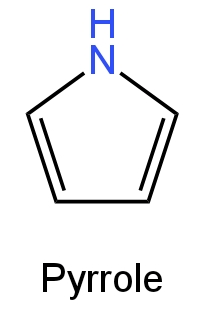
Answer
111k+ views
Hint: Chlorophyll is a green pigment present in the chloroplasts of algae and plants.It is one of the significant elements used in the process of photosynthesis. Photosynthesis is the process through which green plants and other organisms utilise sunlight to prepare nutrients from carbon dioxide and water.
Complete Step by Step Solution:
The colour of green plants is due to the chlorophyll pigment. Pyrrole is a five-membered heterocyclic aromatic organic compound containing a nitrogen atom.
The structure of pyrrole is as follows:

Image: Pyrrole
When four pyrrole subunits are connected through methine bridges, they form a union of heterocyclic organic compounds called porphyrins.
Methine is derived from methane and is a trivalent functional group.

Image: Methine bridge
Metal complexes originating from porphyrins are formed naturally.
Heme, a pigment in red blood cells and also a cofactor of the protein haemoglobin, is one type of the porphyrin complex.
Chlorophyll also originates from porphyrin.
In chlorophyll, the four pyrrole units are attached by a central metal atom which is Magnesium.
Here the central magnesium atom is enclosed by a porphyrin ring which is attached to a long carbon-hydrogen side chain called a phytol chain.
So, option B is correct.
Additional Information: The word chlorophyll originates from the Greek word khloros which means green and phyllon which means leaves.
Chlorophyll is a green pigment that works as a photoreceptor in plants.
Note: Chlorophyll has a crucial part in photosynthesis as it enables the plants to absorb energy from the light given by the sun. This energy is later used to carry on the photosynthesis process. Magnesium is an important unit of chlorophyll. Chlorophyll is categorised into five types i.e., chlorophyll a, b, c, d, and d and e.
Complete Step by Step Solution:
The colour of green plants is due to the chlorophyll pigment. Pyrrole is a five-membered heterocyclic aromatic organic compound containing a nitrogen atom.
The structure of pyrrole is as follows:

Image: Pyrrole
When four pyrrole subunits are connected through methine bridges, they form a union of heterocyclic organic compounds called porphyrins.
Methine is derived from methane and is a trivalent functional group.

Image: Methine bridge
Metal complexes originating from porphyrins are formed naturally.
Heme, a pigment in red blood cells and also a cofactor of the protein haemoglobin, is one type of the porphyrin complex.
Chlorophyll also originates from porphyrin.
In chlorophyll, the four pyrrole units are attached by a central metal atom which is Magnesium.
Here the central magnesium atom is enclosed by a porphyrin ring which is attached to a long carbon-hydrogen side chain called a phytol chain.
So, option B is correct.
Additional Information: The word chlorophyll originates from the Greek word khloros which means green and phyllon which means leaves.
Chlorophyll is a green pigment that works as a photoreceptor in plants.
Note: Chlorophyll has a crucial part in photosynthesis as it enables the plants to absorb energy from the light given by the sun. This energy is later used to carry on the photosynthesis process. Magnesium is an important unit of chlorophyll. Chlorophyll is categorised into five types i.e., chlorophyll a, b, c, d, and d and e.
Recently Updated Pages
Write an article on the need and importance of sports class 10 english JEE_Main

Write a composition in approximately 450 500 words class 10 english JEE_Main

Arrange the sentences P Q R between S1 and S5 such class 10 english JEE_Main

If x2 hx 21 0x2 3hx + 35 0h 0 has a common root then class 10 maths JEE_Main

The radius of a sector is 12 cm and the angle is 120circ class 10 maths JEE_Main

For what value of x function fleft x right x4 4x3 + class 10 maths JEE_Main

Other Pages
If a wire of resistance R is stretched to double of class 12 physics JEE_Main

The electronic configuration of bivalent europium and class 11 chemistry JEE_Main

A system works in a cyclic process It absorbs 20 calories class 11 chemistry JEE_Main

Electric field due to uniformly charged sphere class 12 physics JEE_Main

A police van moving on a highway with a speed of 30 class 11 physics JEE_Main




